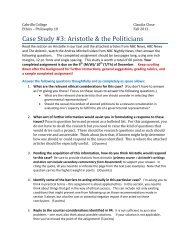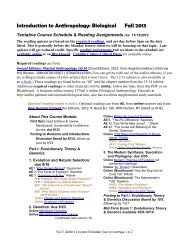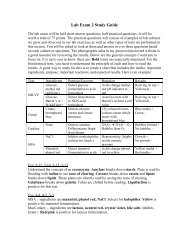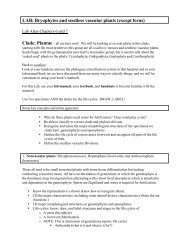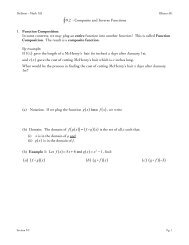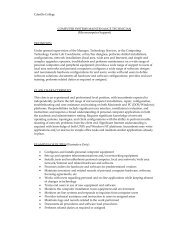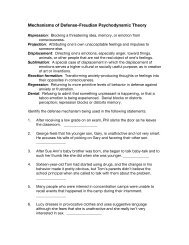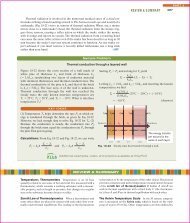Create successful ePaper yourself
Turn your PDF publications into a flip-book with our unique Google optimized e-Paper software.
<strong>Life</strong> <strong>Cycle</strong> <strong>Patterns</strong><br />
We’ll take a look at the basics of life cycles. We will NOT focus on gametic life cycles<br />
as these are primarily for animals (Bio 1B with John!). We’ll look at Fungus (zygotic<br />
life cycle), Algae, Moss, Fern, Flowering Plant (including asexual) (sporic life cycles)<br />
1. First some basics: Fertilization, Mitosis and Meiosis<br />
Fertilization (syngamy) is the fusion of two haploid gametes (the sperm and the egg) to<br />
form a diploid (2n) zygote. This is how the chromosome number in a life cycle changes<br />
from haploid (n) to diploid (2n). The biflagellate sperm in the above illustration is<br />
characteristic of a moss. Human sperm have a single flagellum.<br />
Mitosis is the division of a haploid (n) or diploid (2n) cell into two duplicate daughter<br />
cells. In a strict definition, mitosis (karyokinesis) refers to the division of a nucleus into<br />
two duplicate nuclei, each with identical sets of chromosomes. Cytoplasmic division or<br />
cytokinesis involves a cleavage furrow in animal cells and a cell plate in plant cells. An<br />
example of cell division in haploid cells is the male honey bee (drone bee) which<br />
develops from a haploid unfertilized egg.
Meiosis is a special kind of cell division in which the chromosome number is reduced in<br />
half. This is how the chromosome number in a life cycle changes from diploid (2n) to<br />
haploid (n). In humans, the only cells that undergo meiosis are egg mother cells (oöcytes)<br />
in the ovaries and sperm mother cells (spermatocytes) in the testes. Egg formation and<br />
sperm formation are referred to as oögenesis and spermatogenesis. In flowering plants,<br />
meiosis occurs in megaspore mother cells (megasporocytes) within the ovules of ovaries,<br />
and in microspore mother cells (microsporocytes) within the anthers of stamens. In the<br />
first division (blue cells in above illustration), the homologous chromosome doublets<br />
separate from each other so they are no longer in pairs. In the second and final division<br />
the chromatids of each doubled chromosome separate from each other forming the<br />
haploid gametes. During the first and second divisions of meiosis nondisjunction can<br />
occur, as shown in the following illustration.<br />
In normal spermatogenesis, X-bearing and Y-bearing sperm are produced. If an X-<br />
bearing sperm unites with an X-bearing egg, the resulting zygote is female (XX). If a Y-<br />
bearing sperm unites with an X-bearing egg, the resulting zygote is male (XY).<br />
Sometimes the X and Y chromosomes do not separate properly during the first division<br />
(Anaphase I) or the second division (Anaphase II) during spermatogenesis, a<br />
phenomenon known as nondisjunction. Nondisjunction may result in sperm that carry an<br />
extra X or an extra Y chromosome, such as XX-bearing sperm, XY-bearing sperm and<br />
YY-bearing sperm. If these sperm unite with an X-bearing egg, the result could be XXX<br />
(triple-X syndrome), XXY (Klinefelter's syndrome) or XYY (XYY-syndrome). This is<br />
also one way that polyploidy is achieved in plants – not an uncommon phenomenon.<br />
2. Three major kinds of life cycles: Gametic, zygotic, and sporic
A. Gametic: Animals. Only one multicellular stage: diploid (2n)<br />
B. Zygotic: most Fungi. Often a dominant, multicellular haploid stage (n), transitory<br />
diploid stage (2n)<br />
C. Sporic: Alternation of generations: both haploid (n) and diploid (2n) are multicellular.<br />
Which one is dominant depends on the organism.
3. Examples of zygotic and sporic life cycles:<br />
A. Zygotic: An example of a generic fungal life cycle (zygotic): note the short single<br />
celled diploid stage and the more complex multicellular haploid stage. In some shrooms<br />
the diploid stage has never been seen!
B. Some variations on the sporic life cycle, and some we will be studying:<br />
Algae <strong>Life</strong> cycle (isomorphic alternation of generations):<br />
Algal <strong>Life</strong> cycle: heteromorphic alternation of generations
Note: In The Following <strong>Life</strong> <strong>Cycle</strong>s, Everything Above The Red Line<br />
Is Diploid (2n) And Everything Below The Red Line Is Haploid (n)<br />
Moss <strong>Life</strong> <strong>Cycle</strong>: Dominant gametophyte, dependent sporophyte<br />
Moss <strong>Life</strong> <strong>Cycle</strong>. Mosses belong to the Division Bryophyta characterized by nonvascular<br />
plants with embryos that develop within multicellular female sex organs called<br />
archegonia. The dominant (conspicuous) part of the life cycle is the haploid, leafy<br />
gametophyte. The diploid sporophyte consists of a sporangium-bearing stalk that grows<br />
directly out of the gametophyte. Spore mother cells within the sporangium undergo<br />
meiosis, producing numerous haploid spores that fall to the ground like tiny particles of<br />
dust. Since the sporophyte is without chlorophyll, it is completely dependent on the<br />
autotrophic (photosynthetic) gametophyte for its water, minerals and carbohydrate<br />
nutrition. Consequently, the sporophyte of the moss is heterotrophic and parasitic on the<br />
gametophyte. Most moss gametophytes are dioecious, with separate male and female
individuals in the population. The gametophytes are produced by "male" and "female"<br />
spores. Mosses have a primitive method of fertilization that involves a motile, biflagellate<br />
sperm that swims through water to reach the egg on female plants.<br />
Some lichens superficially resemble mosses from a distance, particularly fruticose<br />
(branched) lichens growing on the branches and trunks of trees. Lichens are essentially<br />
fungi containing symbiotic algal cells. The photosynthetic algae provide carbohydrate<br />
nutrition for the fungus, while the fungus provides a protective place for the algal cells to<br />
thrive in an otherwise hostile environment. Because the relationship or "marriage" is<br />
beneficial to both partners, this particular example of symbiosis is classified as<br />
mutualism.<br />
Fern <strong>Life</strong> <strong>Cycle</strong>: dominant sporophyte:<br />
Fern <strong>Life</strong> <strong>Cycle</strong>. Ferns belong to the Division Pterophyta characterized by vascular plants<br />
with leaves (fronds) arising from subterranean, creeping rhizomes. In tree ferns, the<br />
leaves are produced on a definite woody trunk. The dominant (conspicuous) part of the<br />
life cycle is the diploid, leaf-bearing sporophyte. On the underside of the leaves are rows<br />
of brown sori. Each sorus is composed of a cluster of sporangia, and is often covered by a
thin outer layer called the indusium. Some ferns such as Polypodium and Cyrtomium do<br />
not have the indusium. Ferns are classified by the arrangement of the sori and shape of<br />
the indusium. The sori and indusium superficially resemble an infestation of scale insects,<br />
and some people actually spray their ferns! Spore mother cells within the sporangium<br />
undergo meiosis, producing numerous haploid spores. The sporangia split open at<br />
maturity, releasing millions of spores that fall to the ground like tiny particles of dust.<br />
The splitting open of a sporangium is caused by a thick-walled, outer belt of cells called<br />
the annulus. As the cells of the annulus dry out, the annulus contracts and rips open the<br />
sporangial wall, thus dispersing the spores.<br />
Each spore germinates and grows into a heart-shaped gametohyte (prothallus) which is<br />
smaller than your little finger nail. This haploid gametophyte bears male and female sex<br />
organs (antheridia and archegonia). With respect to populations of gametophytes, ferns<br />
are typically monoecious with both male and female sex organs on the same<br />
gametophytes. Unlike the unisexual gametophytes of a moss, a fern gametophyte is<br />
bisexual. Like mosses, ferns have a primitive method of fertilization that involves a<br />
multiciliate sperm that swims through water to reach the egg. The gametophytes and<br />
sporophytes of ferns are photosynthetic and autotrophic.<br />
Flowering Plant <strong>Life</strong> <strong>Cycle</strong>
Flowering Plant <strong>Cycle</strong>. Flowering plants (angiosperms) belong to the vascular plant<br />
division Anthophyta. Like ferns, the diploid sporophyte consists of a herbaceous or<br />
woody plant with roots, stems and leaves. Unlike ferns, flowering plants produce<br />
reproductive organs called flowers and seed-bearing fruits. The term angiosperm is<br />
derived from angio (vessel) and sperm (seed), referring to the seed-bearing vessels<br />
(containers) called fruits. Flowers may be unisexual or bisexual, depending on whether<br />
they contain only one type of sex organ (the male stamen or female pistil), or whether<br />
they contain both stamens and pistil in the same flower. Species with separate male and<br />
female flowers on the same plant are termed monoecious, including oaks (Quercus), alder<br />
(Alnus) and walnut (Juglans). Species with separate male and female flowers on separate<br />
individuals are termed dioecious, including willows (Salix), cottonwoods (Populus), date<br />
palms (Phoenix), some figs (Ficus) and marijuana (Cannabis). The following illustration<br />
shows a typical bisexual flower:<br />
The general evolutionary trend is a gradual increase in the diploid sporophyte phase and<br />
a decrease in the gametophyte phase. In the moss, the diploid phase consists of a<br />
sporangium and stalk that grows out of the haploid female gametophyte. In the fern and<br />
flowering plant, the entire leaf-bearing plant is diploid. The haploid gametophye of a fern<br />
is reduced to a small, heart-shaped prothallus. In flowering plants, the haploid<br />
gametophyte is greatly reduced and consists of two microscopic structures: A sevencelled,<br />
eight-nucleate embryo sac containing the egg and endosperm mother cell, and a<br />
pollen grain plus pollen tube containing 3 nuclei, two of which are the sperm which<br />
penetrate the embryo sac during fertilization.<br />
Asexual reproduction:<br />
Many species of plants reproduce asexually without gametes. They simply clone<br />
themselves by the formation of bulbs, corms, tubers, rhizomes, runners, turions, plantlets<br />
and "pups." In the duckweed family (Lemnaceae) daughter plants are produced<br />
vegetatively in budding pouches. Each "mother plant" produces up to a dozen daughter<br />
plants during its lifetime of 1-2 (or more) months. The daughter plants repeat the budding<br />
history of their clonal parents, resulting in exponential growth. It has been estimated that<br />
the Indian Wolffia microscopica may reproduce asexually by budding every 30 hours<br />
under optimal growing conditions. At the end of 4 months this would result in about 1<br />
nonillion plants (1 followed by 30 zeros) occupying a total volume roughly equivalent to<br />
the planet earth. Some of these methods are discussed under vegetative terminology at the<br />
following links:



